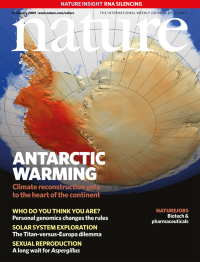Volume 457
-
No. 7233 26 February 2009
The fourth International Polar Year began in 2007 and is only now drawing to a close. This week we look back at the achievements of IPY4, and forward to the fate of the poles in a warming climate. The cover image, taken in Nunavut, Canada, in 2000, shows an Inuit hunter walking on summer ice floe in midnight sun (Rob Howard/CORBIS).
-
No. 7232 19 February 2009
Can science thrive during an economic downturn? In a series of seven Commentaries, introduced on page 957, specialists in policy-making, history, economics and innovation offer advice that might help. For more online extras see www.nature.com/recessionwatch [Cover illustration: Daniel Mackie.]
-
No. 7231 12 February 2009
The second of Natures three Darwin 200 special issues celebrates everybodys Darwin the great mans legacy in the context of the human condition. For a listing of all Darwin-related content from this issue, see the Editorial. All of this content, plus web-only material, is available at www.nature.com/darwin. [Cover graphic by Joe Magee.]
Insight
-
No. 7230 5 February 2009
After the doubling of the US National Institute of Healths budget between 1998 and 2003, the agency entered a period of budget stagnation, and as a result competition for research project grants such as the R01 has now reached a new, more savage intensity. At the personal level loss of an R01 can mean a long, painful battle for a laboratorys survival, as Meredith Wadman relates in two cautionary tales this week. [Cover illustration by David Parkins.]
-
No. 7229 29 January 2009
Spitzer Space Telescope observations, reported by Laughlin et al. this week, provide a first glimpse of time-varying weather on an extrasolar planet. The cover image represents the calculated optical emission from the planet: the blue crescent is scattered starlight, and the colour arises from a combination of Raleigh scattering and absorption by alkali metal ions. The equatorial jet and high-latitude vortices on the night side are glowing with their own intrinsic thermal emission. [Image: D. Kasen.]
-
No. 7228 22 January 2009
A new reconstruction of Antarctic surface temperature trends for 19572006, reported this week by Steig et al., suggests that overall the continent is warming by about 0.1 °C per decade. The cover illustrates the geographic extent of warming, with the hotspot peninsula and West Antarctica shown red against the white ice-covered ocean. [Cover image: NASA Goddard Space Flight Center/University of Washington/USGS]
Insight
-
No. 7227 15 January 2009
Can he do it? The cover shows Barack Obama and George W. Bush prior to their 10 November Oval Office meeting. The handover takes place next week. In this issue we look at the Bush legacy, and the emerging policies of the Obama administration. [COVER PICTURE: Mandel Ngan/AFP/Getty Images]
-
No. 7226 8 January 2009
Space is not completely empty; the vacuum teems with quantum mechanical energy fluctuations able to generate an attractive force between objects that are very close to each other. This Casimir Lifshitz force can cause static friction or stiction in nanomachines, which must be strongly reduced. Until now only attractive interactions have been reported but in theory, if vacuum is replaced by certain media, Casimir-Lifshitz forces should become repulsive. This has now been confirmed experimentally. Repulsion, weaker than the attractive force, was measured in a carefully chosen system of interacting materials immersed in fluid. The magnitude of both forces increases as separation decreases. The repulsive forces could conceivably allow quantum levitation of objects in a fluid and lead to new types of switchable nanoscale devices with ultra-low static friction. Levitation depends only on the dielectric properties of the various materials. The cover illustrates repulsion between a tiny gold sphere and a silica substrate (left). Replace the silica with gold (right), and the force becomes attractive.
-
No. 7225 1 January 2009
Marking the International Year of Astronomy (IYA), Jeff Kanipe takes a look at the prospects of the 'big four' major new telescopes [News Feature p. 18]. They have a tough act to follow, as a trawl through 'Hubble's greatest hits' reveals [Review Article p. 41]. The 'Dark Skies Awareness' campaign is part of IYA 2009; Malcolm Smith argues the case for a transformation that would not only help astronomers but would also benefit human health and energy conservation [Commentary p. 27]. Also part of IYA 2009 is the celebration of 400 years of the telescope; Owen Gingerich tracks the link between technology and our changing world-view [Essay p. 28]. Robert Poole's book Earthrise focuses on the psychological impact of the Apollo 8 image of Earth over the lunar horizon, though our reviewer feels that our attitudes towards our planet have not changed enough [Books & Arts p. 30]. 'Hidden treasures' visits the Paris Observatory [p. 33] and astronaut Alan Bean talks about his moonscape paintings [p. 31]. In Futures, David Blair looks back on 2009 [p. 122] and in a Letter, Alyssa Goodman et al. reveal the importance of self-gravity in star formation [p. 63]. See the Editorial [p. 7] and visit www.nature.com/astro09 for more. COVER PICTURE: Hubble Space Telescope/Christian Darkin









